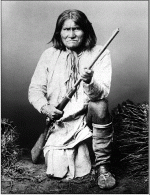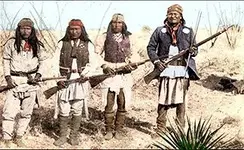Oroblanco
Gold Member
- Joined
- Jan 21, 2005
- Messages
- 7,840
- Reaction score
- 9,877
- Golden Thread
- 0
- Location
- DAKOTA TERRITORY
- Detector(s) used
- Tesoro Lobo Supertraq, (95%) Garrett Scorpion (5%)
- #221
Thread Owner
What is this, paddycake or Tag? You posted about Anza having Peraltas on Sept 11, however I posted it on « Reply #152 on: September 06, 2006, 03:20:55 PM » (LDM hunt is anyone up for it)
http://forum.treasurenet.com/index.php/topic,29161.msg340628.html#msg340628
(extract)
I have always had a problem with the whole Peralta tale(s) as I never found any evidence of anyone with the name Peralta living in the area that is now southern AZ until recently. (A list of the persons enlisted in the DeAnza expedition includes a family of Peraltas, though this is late 1700s not 1847 and the family was in the process of moving to California so...not that good a proof of any Peraltas living in Sonora.)
So now I don't read. I don't arrive at the same conclusions, so I must be arbitrary, in a case that cannot be proven. You prefer to accept Edwards tale, I don't. You prefer Dana's conclusions, I don't. You admit respect for Jim Hatt, but ignore what he says about trying to find a date on inscribed stones. You prefer to accept the tales of lost Peralta gold mines in the Superstitions, I don't. I DO accept that there are two lost mines in that region, but not Mexican. The whole massacre story is not even officially recognized by history, (look for it if you doubt this) and even if they ARE a pack of Mexicans that NO ONE ever missed a man of, it does not mean they were working mines IN the Superstitions, but no matter. Edward's story is a great one, might even make a good movie but...are you willing to take it at face value? Apparently yes!
Who can prove the actual age of the heart stone, or that it must pre-date the arrival of Europeans if it is to be Indian? If it is also a modern fake, why should we be surprised if it is a European symbol? Would you presume that a petroglyph that shows a man on a horse MUST be not be dating to the 1800s because Europeans introduced the horse?
I notice that you just won't answer my question about whether the statements of Mr Hatt about dating those stones affects your view of Dana's conclusions. This is not the first time you have not answered questions, even when repeated. Did you think it was a facetious or purely rhetorical question? I wasn't trying to be "funny", I wanted to know if his statements affects how you view Dana's conclusions, which none of us has actually ever seen first-hand. It seems obvious that Mr Hatt's statements, which are pretty correct about the difficulties of getting a date of inscriptions in stones doesn't change your 'leaning' to a belief that the stones are genuine.
So yep by your reasoning I am being really, really arbitrary about what I will believe and what I will NOT believe. It takes some backing to allow me to believe in a lost treasure or lost mine, let alone a whole BUNCH of lost mines and in this case I just don't see it. Most myths have a basis in fact, however not ALL myths are 100 percent true.
Roy ~ Oroblanco
http://forum.treasurenet.com/index.php/topic,29161.msg340628.html#msg340628
(extract)
I have always had a problem with the whole Peralta tale(s) as I never found any evidence of anyone with the name Peralta living in the area that is now southern AZ until recently. (A list of the persons enlisted in the DeAnza expedition includes a family of Peraltas, though this is late 1700s not 1847 and the family was in the process of moving to California so...not that good a proof of any Peraltas living in Sonora.)
So now I don't read. I don't arrive at the same conclusions, so I must be arbitrary, in a case that cannot be proven. You prefer to accept Edwards tale, I don't. You prefer Dana's conclusions, I don't. You admit respect for Jim Hatt, but ignore what he says about trying to find a date on inscribed stones. You prefer to accept the tales of lost Peralta gold mines in the Superstitions, I don't. I DO accept that there are two lost mines in that region, but not Mexican. The whole massacre story is not even officially recognized by history, (look for it if you doubt this) and even if they ARE a pack of Mexicans that NO ONE ever missed a man of, it does not mean they were working mines IN the Superstitions, but no matter. Edward's story is a great one, might even make a good movie but...are you willing to take it at face value? Apparently yes!
Who can prove the actual age of the heart stone, or that it must pre-date the arrival of Europeans if it is to be Indian? If it is also a modern fake, why should we be surprised if it is a European symbol? Would you presume that a petroglyph that shows a man on a horse MUST be not be dating to the 1800s because Europeans introduced the horse?
I notice that you just won't answer my question about whether the statements of Mr Hatt about dating those stones affects your view of Dana's conclusions. This is not the first time you have not answered questions, even when repeated. Did you think it was a facetious or purely rhetorical question? I wasn't trying to be "funny", I wanted to know if his statements affects how you view Dana's conclusions, which none of us has actually ever seen first-hand. It seems obvious that Mr Hatt's statements, which are pretty correct about the difficulties of getting a date of inscriptions in stones doesn't change your 'leaning' to a belief that the stones are genuine.
So yep by your reasoning I am being really, really arbitrary about what I will believe and what I will NOT believe. It takes some backing to allow me to believe in a lost treasure or lost mine, let alone a whole BUNCH of lost mines and in this case I just don't see it. Most myths have a basis in fact, however not ALL myths are 100 percent true.
Roy ~ Oroblanco




 I was repeating the question because I got the impression you were deliberately ignoring it.
I was repeating the question because I got the impression you were deliberately ignoring it. 






